
Sharing the treasures of Iburi with future generations.
The Five Great Heritages of Iburi

The Iburi area situated in southwestern Hokkaido is home to precious regional resources that are rare no matter where you look in the world. Hokkaido Government Iburi General Subprefectural Bureau is committed to sharing information on these rare, charming sites known collectively as the Five Great Heritages of Iburi. These include the Toya-Usu UNESCO Global Geopark, the Ainu Culture, Jomon Prehistoric Sites, the Kamuysaurus japonicus (Mukawa Ryu) dinosaur, and Tan-Tetsu-Ko (Coal-Iron & Steel-Railway-Port).
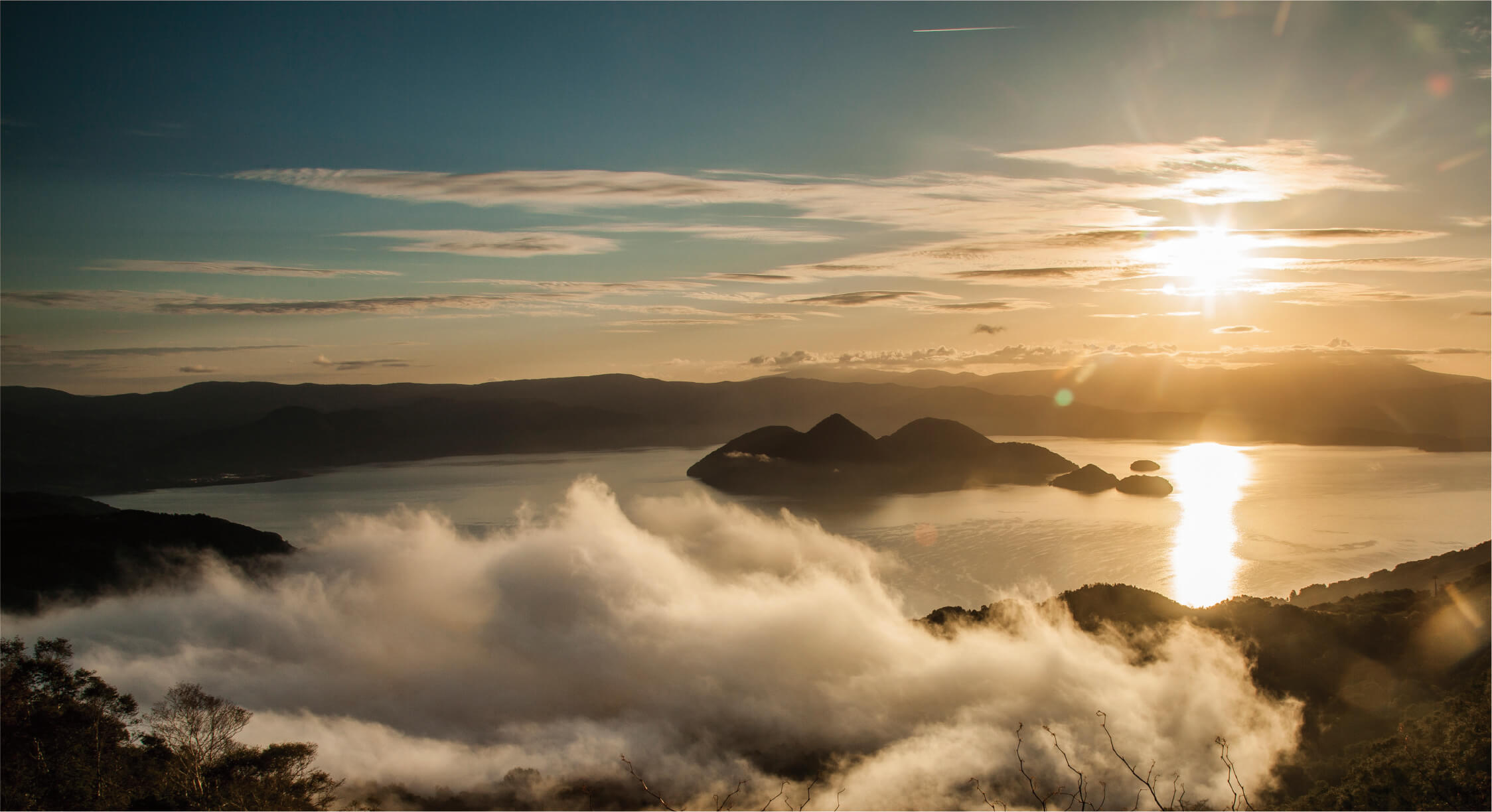
Iburi Geological Heritage
Toya-Usu UNESCO Global Geopark
Toya-Usu UNESCO Global Geopark is based on the idea of coexistence with the changing earth. Covering 1,064 square kilometers, the area consists of the towns of Date, Toyoura, Sobetsu, and Toyako, with Lake Toya at the center. It was certified as a global geopark in 2009, then formally certified as a UNESCO Global Geopark in November 2015 by UNESCO (United Nations Educational, Scientific and Cultural Organization).
*Geopark: A precious location where visitors can enjoy learning about the living Earth and our connection with life.
Preserving ruins damaged in volcanic eruptions as-is
Lake Toya was formed nearly 110,000 years ago during a massive volcanic eruption, and Mt. Usu was formed nearly 20,000 years ago over the course of repeated eruptions. Mt. Usu is an active volcano that has erupted every 20 to 30 years since the Edo period, with volcanic activity last reported in 2000. Toya-Usu UNESCO Global Geopark’s most prominent feature is that people continue to live right next to an active volcano. To ensure that the memories of past eruptions and damages do not fade, buildings and roads that were damaged in past eruptions are preserved as-is, and are part of walking paths that can be visited in the park.
Coexisting with a volcano
For people to continue living in the area, they need to be aware of how to coexist with the volcano and to prepare for eruptions. Tours guided by the Toyo-Usa Volcano Meisters, who serve as local disaster preparedness leaders and promote the charms of the area, and by guides well versed in volcanoes, natural disasters, and disaster prevention, are quite popular. The dynamic landscapes, abundance of hot springs bubbling forth in the area, and the bounty of the land and sea are all thanks to the volcano. Enjoy these charming aspects that call to mind thoughts of the Earth itself for the best way to experience Toya-Usu UNESCO Global Geopark.
Info Link
Toya-Usu UNESCO Global Geopark
Recommended Spot
Toyako Visitor Center and Volcano Science Museum
| Adress | Toyakoonsen 142-5, Toyako |
| TEL | 0142-75-2555 |
| Hours | 9:00 a.m. – 5:00 p.m. |
| Scheduled Day Off | December 31 – January 3 |
| By car /expressway | From Sapporo-kita IC: Approx. 1 hr. 50 min. From New Chitose Airport IC: Approx. 1 hr. 20 min. |
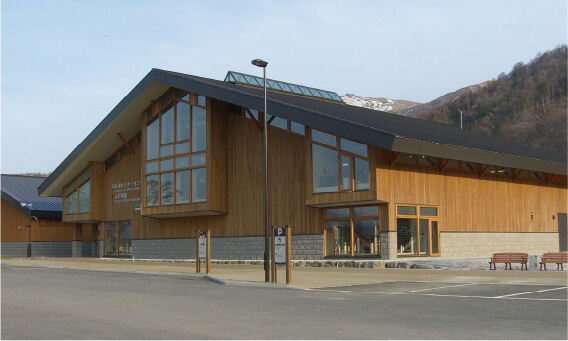
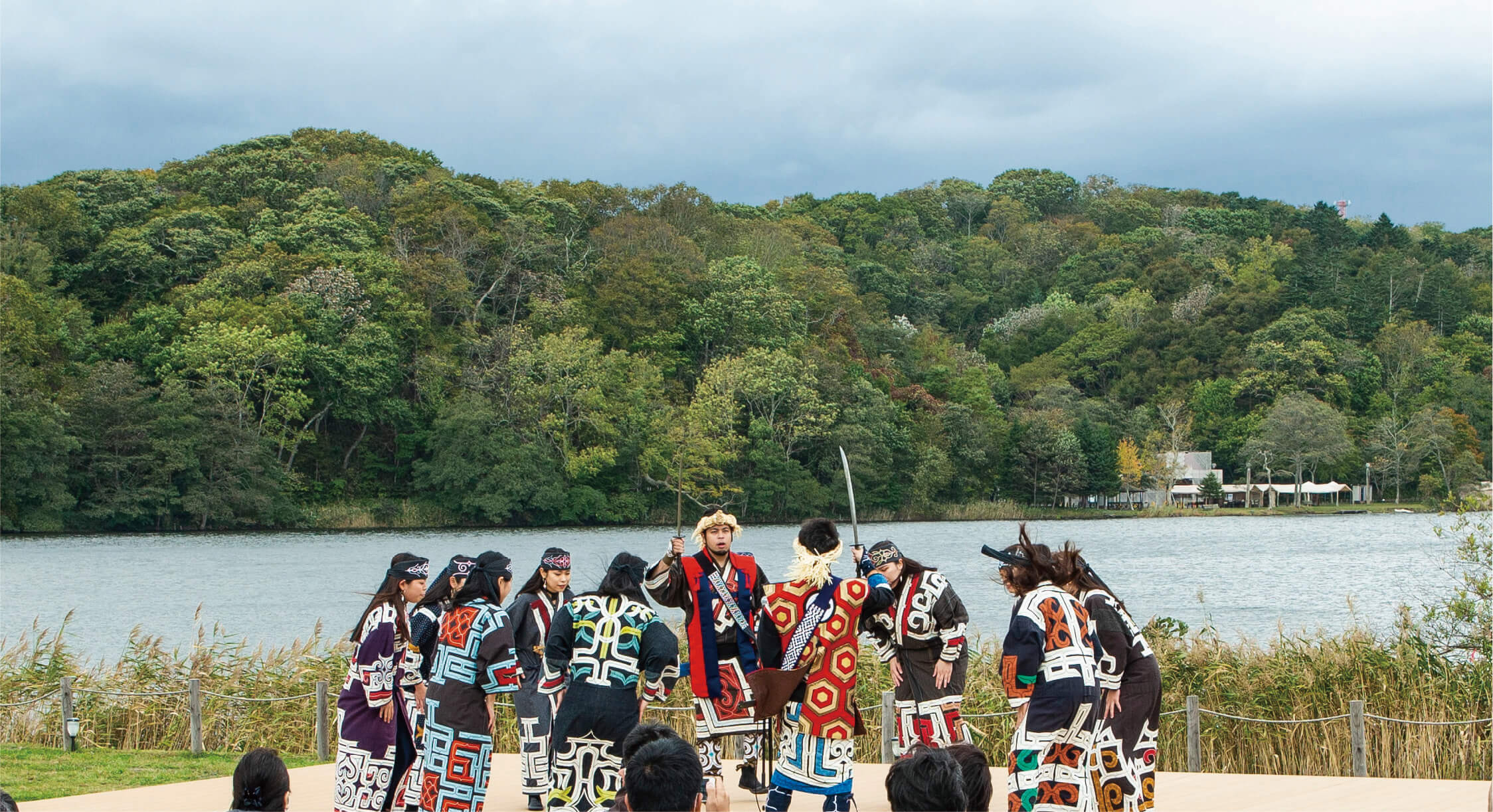
Iburi Cultural Heritage
Ainu Culture
The Ainu are indigenous people from the northernmost part of the Japanese archipelago, Hokkaido. They have developed a unique culture includes their own language called Ainu, a religious view that spirits reside in all things, embroidery with distinct patterns, and crafts such as wood carving. Traditional Ainu dance, which is performed at festivals and household events, is designated as an important intangible folk cultural asset by the Japanese government, and registered as a UNESCO Intangible Cultural Heritage*.
*UNESCO Intangible Cultural Heritage: In regard to World Heritage sites, which are tangible cultural assets that are designated for protection and succession, Intangible Cultural Heritages cover folk cultural assets, folklore, oral traditions, and other intangible items.
Traditional Ainu dance, born from everyday life
The Ainu often sang and danced during ceremonies, get-togethers, and while working. They have a variety of dances, some performed in a large circle called rimse, upopo, and horippa, which represented prayers to the spirits, while others were prayers for bounteous hunting and fishing, and others represented the movements of animals, with those present singing, clapping, and dancing together. For the Ainu, dancing was a way to enjoy being with the deities. Currently there are 18 conservation groups registered as important intangible folk cultural assets by the Japanese government which perform dances at major Ainu festivals and pass on songs that were once sung by individuals to ensure that they survive by being shared.
Visiting the Upopoy National Ainu Museum and Park
Upopoy National Ainu Museum and Park is a national center established July 12, 2020 on the shores of Poroto Lake in Shiraoi as a place to revive and develop indigenous Ainu culture. This spot is surrounded by abundant nature, and the grounds are also a place for relaxation where visitors can see living, breathing Ainu culture. It is home to the national Ainu Museum, which is the first in Japan to feature the Ainu, and National Ainu Park, a type of hands-on field museum. Visitors to the Cultural Exchange Hall can experience traditional Ainu performing arts such as the traditional Ainu dance and musical performances.
Info Link
Upopoy Portal
Recommended Spot
Upopoy National Ainu Museum and Park
| Adress | Wakakusacho 2-chome 3, Shiraoi |
| TEL | 0144-82-3914 |
| Hours | April 1 – October 31: 9:00 a.m. – 6:00 p.m. (weekdays), 9:00 a.m. – 8:00 p.m. (weekends and holidays) July 16 – August 28: 9:00 a.m. – 8:00 p.m. November 1 – March 31: 9:00 a.m. – 5:00 p.m. |
| Scheduled Day Off | Monday (closed the following weekday when Monday falls on a holiday) and year-end/New Year holidays (December 29 – January 3) ※Please check website for the latest information. |
| By car /expressway | From Sapporo-kita IC: Approx. 1 hr. 5 min. From New Chitose Airport IC: Approx. 40 min. |

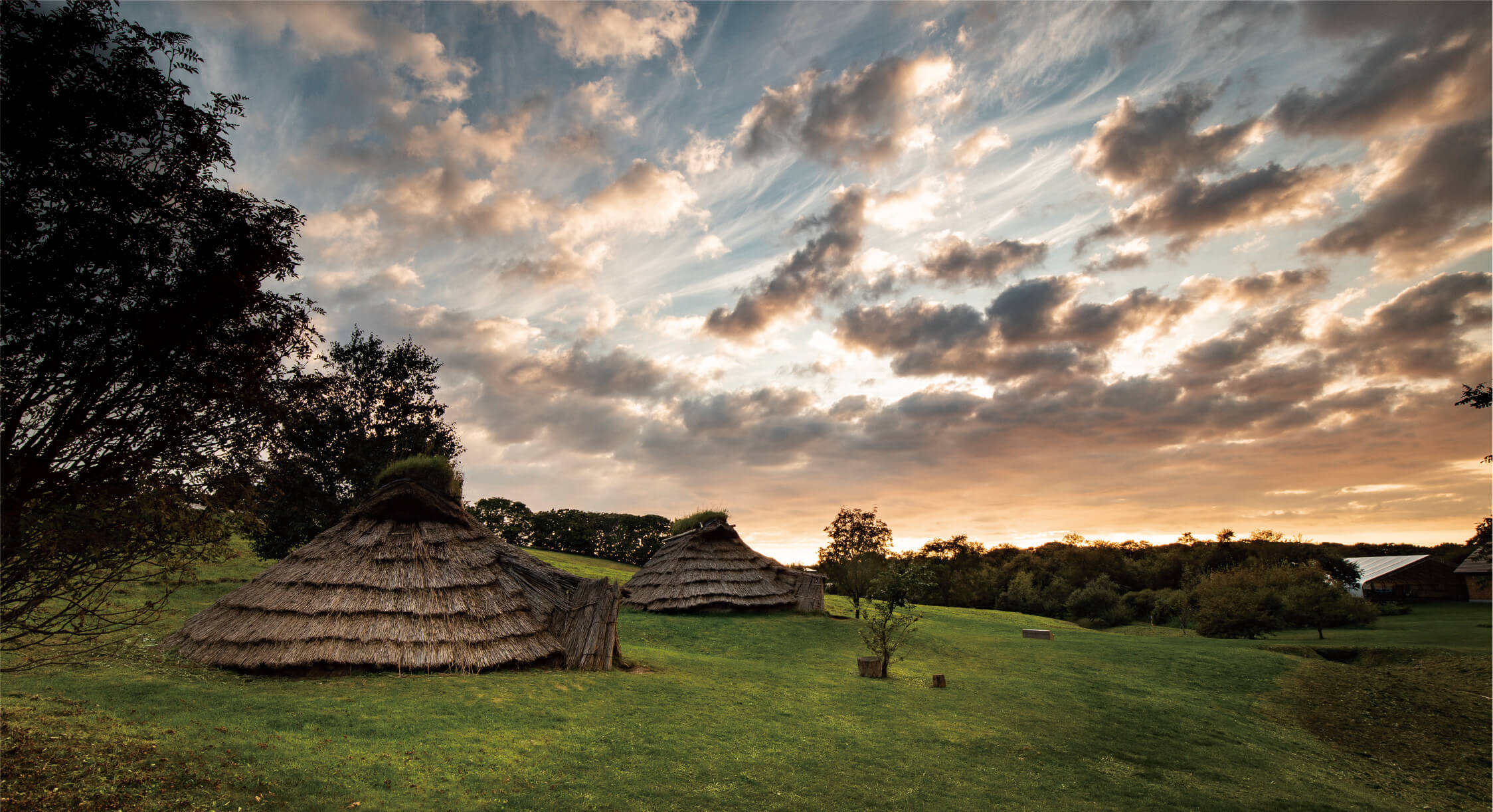
Iburi Historical Heritage
Jomon Prehistoric Sites
The Jomon culture, which lasted for nearly 10,000 years, possessed superb technology and rich spiritual views, making them one of the world’s foremost advanced and mature prehistoric cultures.
There are many Jomon sites in Iburi, and the Jomon Prehistoric Sites in Northern Japan*, which include the Kitakogane Shell Mound (Date) and the Irie-Takasago Shell Mound (Toyako), are registered as a UNESCO World Heritage site.
*Jomon Prehistoric Sites in Northern Japan: A total of 17 sites including 6 in Hokkaido, 8 in Aomori, 1 in Iwate, and 2 in Akita.
The Kitakogane Shell Mound, a comprehensively well-preserved site
Kitakogane, Date is home to an early Jomon period (approximately 7,000 to 5,000 years ago) site known as the Kitakogane Shell Mound. The site covers 300,000 m2, approximately 90,000 m2 of which is designated as a national historic site. Shells, fish bones, and human bones have been unearthed here, and because the human bones are so well preserved, they are used as reference materials for ancient human skeleton research in Hokkaido. The area around the shell mound is a public park which is home to the Kitakogane Shell Mound Information Center, where visitors can see models of excavated items, a cross section of the shell mound, a burial ground, etc., and try making a magatama bead and experience simulated excavations.
Irie-Takasago Shell Mound, showcasing features of fishing culture
The Irie Shell mound, located on a plateau in Toyako dates from the early (approximately 5,000 years ago) to late (approximately 3,000 years ago) Jomon period, and was preserved due to being buried in volcanic ash from the Mt. Usu eruption in 1663. Shells, animal bones, and the bones of marine creatures such as whales have been unearthed at the mound. The Takasago Shell Mound on the opposite side of the Irie Shell Mound with the Irie Takasago Museum in the middle, is a midden made in the late Jomon period (approximately 3,500 years ago), and 28 tombs made in the late stages of the Jomon period (approximately 2,500 years ago) have been found here along with stone circles nearby.
Info Link
Jomon Prehistoric Sites in Northern Japan
Recommended Spot
Kitakogane Shell Mound Information Center
| Adress | Kitakoganecho 75, Date |
| TEL | 0142-24-2122 |
| Hours | 9:00 a.m. – 5:00 p.m. |
| Scheduled Day Off | December – March |
| By car /expressway | From Sapporo-kita IC: Approx. 1 hr. 35 min. From New Chitose Airport IC: Approx. 1 hr. 5 min. |
Recommended Spot
Irie Takasago Museum
| Adress | Takasagocho 44,Toyako |
| TEL | 0142-76-5802 |
| Hours | 9:00 a.m. – 5:00 p.m. |
| Scheduled Day Off | Monday, the day following a holiday, December – March |
| By car /expressway | From Sapporo-kita IC: Approx. 1 hr. 50 min. From New Chitose Airport IC: Approx. 1 hr. 20 min. |

Iburi Ancient Heritage
Kamuysaurus japonicus (Mukawa Ryu)
The Kamuysaurus japonicus, also know as the Mukawa Ryu, is a dinosaur fossil discovered in strata that was part of the ocean nearly 72 million years ago (late Cretaceous period) in Hobetsu, Mukawa. More than 80% of the 8-meter-long skeleton remains, a rarity among dinosaur bones. This was the first large, complete fossilized dinosaur skeleton discovered in Japan, and the first complete fossilized dinosaur skeleton in Japan discovered in ocean strata. It was later classified as a new species of Hadrosaurus and named Kamuysaurus japonicus*.
*Kamuysaurus japonicus: The scientific name is acombination of kamuy, the Ainu word for god or spirit, and saurus, the Latin word for lizard, or dragon, and finally japonicus, the Latin word for Japan.
The largest complete dinosaur skeleton in Japan changed history
Hobetsu, Mukawa, where the Mukawa Ryu skeleton was excavated, was part of the ocean long ago. Although dinosaurs were land animals, it is believed that the Mukawa Ryu was washed into the ocean where it sank, was buried, and then fossilized. By simply arranging the bones that were discovered, it was possible to gain a rough picture of the dinosaur, making this skeleton a major landmark in the history of Japanese dinosaur research. Measuring nearly 8 meters from its mouth to the end of its tail, standing nearly 3.8 meters high at its back, and weighing an estimated 4 to 5.3 tons, it is currently the largest complete dinosaur skeleton in Japan.
The promise of advances in global dinosaur research
The caudal vertebra discovered by a man at a cliffside stream in town in 2003 were determined to be those of a Plesiosaur. In 2011, however, it was revealed that the bones belonged not to a Plesiosaur, but to a dinosaur. The complete fossilized skeleton, excavation of which began in 2013, was named the Mukawa Ryu in 2016, and later research showed that it was a new species of dinosaur. On September 6, 2019, it was given the scientific name Kamuysaurus japonicus. In Asia, the inland country of Mongolia is a famous spot for dinosaur fossil excavation, but continued digs along ancient Asian coastlines including Japan could be the beginning of a new page in dinosaur research.
Info Link
Mukawa Dino World
Info Link
Hobetsu Museum official site
Recommended Spot
Mukawa Town Hobetsu Museum
| Adress | Hobetsu 80-6, Mukawa |
| TEL | 0145-45-3141 |
| Hours | 9:00 a.m. – 5:00 p.m. (final entry: 4:30 p.m.) |
| Scheduled Day Off | Monday, the day following a holiday, year-end/New Year holidays |
| By car /expressway | From Sapporo-kita IC: Approx. 1 hr. 40 min. From New Chitose Airport IC: Approx. 1 hr. 20 min. |
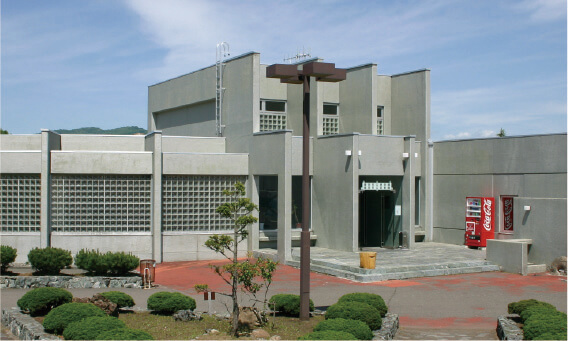
*The complete skeleton reconstruction of the Mukawa Ryu is currently not on display, however, part of the actual fossil is on display at the Mukawa Town Hobetsu Museum.
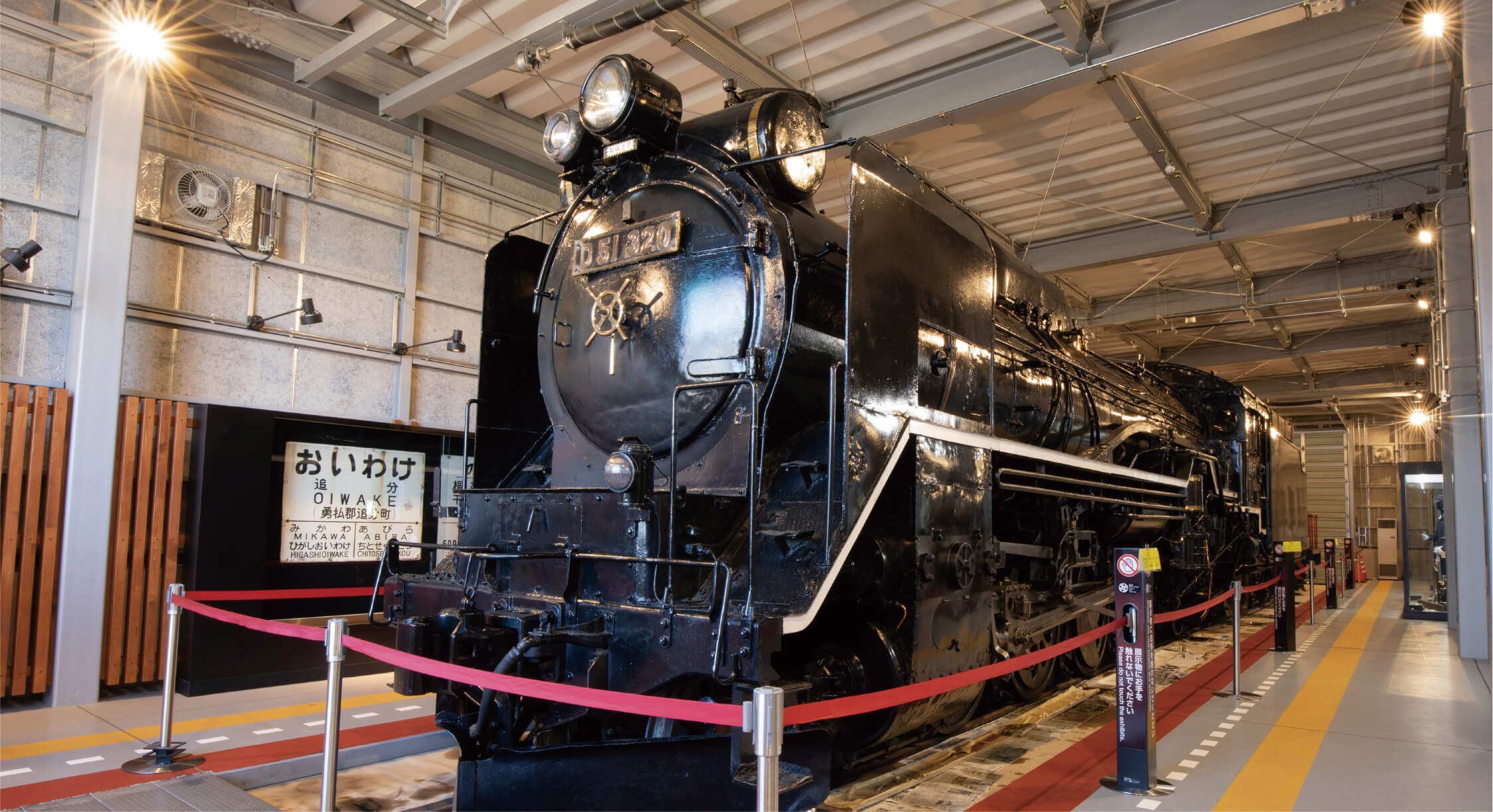
Iburi Industrial Heritage
Tan-Tetsu-Ko (Coal-Iron & Steel-Railway-Port)
Tan-Tetsu-Ko is an initiative attempting to create a new movement among people and knowledge by linking the three cities (Sorachi, Muroran, Otaru) responsible for building modern Hokkaido on the themes of coal, steel, ports, and railroads. Unravel its history and you begin to see the tale of the industrial revolution in Hokkaido. The story of Tan-Tetsu-Ko was selected by the Agency for Cultural Affairs as a Japan Heritage* on May 20, 2019.
*Japan Heritage: A program by the Agency for Cultural Affairs certifies stories that communicate the culture and traditions of Japan through the historical charms and characteristics of local communities. It consists of 23 coal mines, 5 steel production sites, 5 ports, and 12 railroads for a total of 45 heritages.
The story of three cities that helped build Hokkaido
The catalyst that modernized Hokkaido was the opening of the government-run Horonai Coal Mine in 1879. The Horonai Railway, which carried coal from Sorachi to Otaru Port, also helped in the development of Sapporo. Muroran, to which the railway was extended in 1892, became a coal shipping port, and then an iron town when Japan Steel Works was established there in 1907 and when Hokkaido Colliery & Steamship Wanishi Ironworks was established in 1909. At the same time that the railroad was extended to Muroran, the Oiwake Engine Shed was built at Oiwake Station in current day Abira where it was used as a base of operations. The railroad that linked Sorachi, Otaru, and Muroran, and the core industries of coal, ports, and steel production in these three cities played a pivotal role in the rapid development of Hokkaido.
Urban development driven by the history of Tan-Tetsu-Ko (Coal-Iron & Steel-Railway-Port)
During its heyday, nearly 60% of coal from Hokkaido was shipped to Honshu, however, Muroran Port’s role as a coal shipping port ended in 1976. In 1975, the last steam locomotive in Japan that carried passengers between Muroran and Iwamizawa was repurposed to carry freight between Oiwake and Yubari. Nowadays, Muroran is known for its dreamlike night scenery of factories and the Former Muroran Station Building registered as a tangible cultural asset by the Japanese government. Road Rest Area Abira D51 Station opened in Abira in 2019, and promotes urban development using the history of Tan-Tetsu-Ko with displays on steam locomotives and railway related items.
Info Link
Tan-Tetsu-Ko (Coal-Iron & Steel-Railway-Port)
Recommended Spot
Former Muroran Station Building (Tourist Information Center)
| Adress | Kaigancho 1-chome 5-1, Muroran |
| TEL | 0143-23-0102 (Muroran Tourist Office) |
| Hours | 8:00 a.m. – 7:00 p.m. (November – March: to 5:00 p.m.) |
| Scheduled Day Off | January 1,2023 |
| By car /expressway | From Sapporo-kita IC: Approx. 1 hr. 40 min. From New Chitose Airport IC: Approx. 1 hr. 5 min. |
Recommended Spot
Road Rest Area Abira D51 Station
| Adress | Oiwakekashiwagaoka 49-1, Abira |
| TEL | 0145-29-7751 |
| Hours | 9:00 a.m. – 6:00 p.m. (November – March: to 5:00 p.m.) |
| Scheduled Day Off | December 31 – March 3 |
| By car /expressway | From Sapporo-kita IC: Approx. 45 min. From New Chitose Airport IC: Approx. 25 min. |
Deepen your knowledge on a journey of curiosity.
Iburi Museums
Muroran Folklore and Historic Museum (Ton Ten Kan) Muroran
This museum features displays on the history and culture of Muroran from various viewpoints. It is home to a collection of nearly 22,000 pieces including buried cultural properties, with a wealth of Zoku-Jomon period artifacts.
| Adress | Jinyamachi 2-chome 4-25, Muroran |
| TEL | 0143-59-4922 |
| Hours | 10:00 a.m. – 4:00 p.m. |
| Scheduled Day Off | Monday, the day following a holiday, year-end/New Year holidays, January 20 – March 19 |
Tomakomai City Museum Tomakomai
This museum is dedicated to exploring, researching, collecting, and storing items related to Tomakomai history, archaeology, nature, culture, and art, and communicates the allure of such areas through displays and educational opportunities.
| Adress | Suehirocho 3-chome 9-7, Tomakomai |
| TEL | 0144-35-2550 |
| Hours | 9:30 a.m. – 5:00 p.m. |
| Scheduled Day Off | Monday (closed the following weekday when Monday falls on a holiday), year-end/New Year holidays (December 29 – January 3) |
Yubutsu Museum Tomakomai
The museum building, whose exterior is modeled on the Yubutsu Meeting House from the end of the Edo period, is home to furnishings reminiscent of that era as well as displays of items excavated from the Benten Shell Mound, Ainu tribal items, and Edo period cargo ships.
| Adress | Yufutsu 132-32, Tomakomai |
| TEL | 0144-56-0201 |
| Hours | 10:00 a.m. – 5:00 p.m. |
| Scheduled Day Off | Monday (closed the following weekday when Monday falls on a holiday), year-end/New Year holidays (December 29 – January 3) |
Noboribetsu City Folk Museum Noboribetsu
This museum features displays on the Katakura clan, feudal retainers of the Sendai domain who migrated to Noboribetsu, as well as Ainu cultural items. The building is unique for its exterior, which is modeled on Shiroishi Castle of the Katakura clan.
| Adress | Katakuracho 6-chome 27, Noboribetsu |
| TEL | 0143-88-1339 |
| Hours | 10:00 a.m. – 5:00 p.m. (November – March: to 4:00 p.m.) |
| Scheduled Day Off | Monday (closed the following weekday when Monday falls on a holiday), the day following a holiday, year-end/New Year holidays |
Chiri Yukie Memorial Museum Noboribetsu
Visitors to this museum can learn about the life and accomplishments of Chiri Yukie, who was the first to transcribe Ainu stories in the Roman alphabet in a collection of mythology known as Ainu Shinyoshu.
| Adress | Noboribetsuhoncho 2-chome 34-7, Noboribetsu |
| TEL | 0143-83-5666 |
| Hours | 9:30 a.m. – 4:30 p.m. |
| Scheduled Day Off | Tuesday (open when Tuesday falls on a holiday), winter break (December 20 – end of February) |
Date City Museum of History and Culture Date
This museum consists of the Main Building and Experiential Learning Building. Here, visitors can learn about the history of Date in simultaneous displays that show the cultures of the Jomon, the Ainu, and the samurai.
| Adress | Umemotocho 57-1, Date |
| TEL | 0142-25-1056 |
| Hours | 9:00 a.m. – 5:00 p.m. |
| Scheduled Day Off | Monday (closed the following weekday when Monday falls on a holiday), year-end/New Year holidays (December – end of February) |
Usu Zenkoji Temple Treasure Museum Date
This museum is home to a collection and displays of items designated as important cultural assets by the Japanese government, including pieces from the shogunate government and the Imperial court as well as Hokkaido tangible cultural assets and Ainu tribal items. The museum is only open to visitors with reservations, so make sure to contact them in advance.
| Adress | Usucho 124, Date |
| TEL | 0142-38-2007 |
| Hours | 9:00 a.m. – 5:00 p.m. (by reservation only) |
| Scheduled Day Off | Irregular days |
Kamui Chashi Historic ParkCulture Toyoura
Visitors to this park can see sites of what are thought of as chashi, or hilltop fortifications formerly used by the Ainu. It is designated as Pirikanoka (Ainu word for a group of geological features), a place of scenic beauty by the Japanese government.
| Adress | Rebunge, Toyoura |
Masao Mimatsu Memorial Hall Sobetsu
This memorial hall is home to a collection and display of items from Masao Mimatsu, who drew the Mimatsu Diagram recording detailed observations of the growth of Mt. Showa-Shinzan.
| Adress | Showashinzan 184-12, Sobetsu |
| TEL | 0142-75-2365 |
| Hours | 8:00 a.m. – 5:00 p.m. (November – March: 9:00 a.m. – 4:00 p.m.) |
| Scheduled Day Off | Irregular days January – March |
Sendai Clan Shiraoi Manor House Museum Shiraoi
This museum stands on the site of the Shiraoi Sendai Domain Jinya, a nationally designated historic site. It is home to a collection of nearly 300 pieces including drawings of the historic site, old documents, and weapons.
| Adress | Jinyamachi 681-4, Shiraoi |
| TEL | 0144-85-2666 |
| Hours | 9:30 a.m. – 4:30 p.m. |
| Scheduled Day Off | Monday (closed the following weekday when Monday falls on a holiday), year-end/New Year holidays (December 29 – January 3) |
Karumai Archaeological Site Survey Office Atsumacho
This office is open to the public as a museum of local history, showcasing its collection of nearly 9,000 items with a focus on pieces unearthed during excavation on construction of the Apporo Dam, with a focus on agricultural tools and everyday items.
| Adress | Karumai 205-2, Atsuma |
| TEL | 0145-28-2733 |
| Hours | 9:00 a.m. – 5:00 p.m. |
| Scheduled Day Off | Weekends and holidays (open on advance notice) |
Hobetsuyagai Museum Mukawacho
Pass through the time tunnel and in the forest visitors will see massive ammonites, Plesiosaurs, and other sculptures from the ancient world.
| Adress | Hobetsu 108-2, Mukawa |

